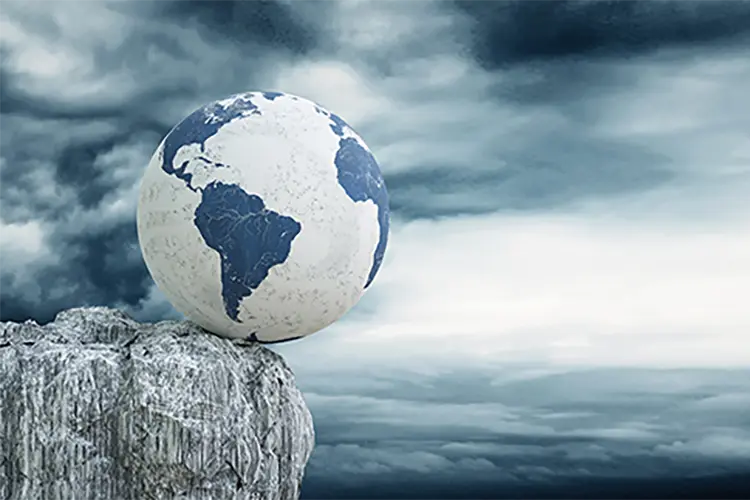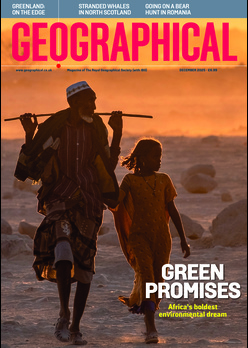
Marco Magrini argues we’re not facing multiple crises – just a single, dangerously interlinked emergency


There’s much more than climate change.
Every year, according to a recent study, hundreds of thousands of tonnes of plastics end up in European and North American farmland. Reduced to millimetres, microns or even nanometres, fragments of plastic have been found in lettuce, wheat and carrots – and then, via eating or inhalation, in human livers, lungs, brains and placentas. Another paper, published in Nature Medicine, estimates that the total mass concentration of plastics in human brains has increased by nearly 50 per cent in the past eight years.
Microplastics have been found in beehives (and in honey), too – adding yet another threat to the already declining ranks of pollinators. These tiny plastic particles join a long list of pressures: rising temperatures, antibiotics, pesticides, habitat loss, urban lighting and more. Some estimates say that pollinator services are worth hundreds of billions of dollars, but the reality is far more critical – they are key to global food security. Around 80 per cent of the world’s crop species require pollination to reproduce. A 2021 study estimated that without pollinators, ‘a third of flowering plant species would produce no seeds, and half would suffer an 80 per cent or more reduction in fertility’.
Plants themselves are under threat from an ancient, yet increasingly potent, foe – fire. Last year’s wildfires released a record 4.1 gigatonnes of carbon, more than four times the emissions from global air travel. For the first time, wildfires – not agriculture – were the leading cause of tropical forest loss. Globally, 6.7 million hectares of primary tropical forest were lost – an area roughly the size of Panama. Boreal forests in Russia and Canada experienced record-breaking blazes. In populated areas – as seen in last year’s tragedy in Los Angeles – wildfires tore through homes, burning the vast quantities of plastic we all keep, releasing toxic chemicals and, again, microplastics.
The interconnectedness of these crises is undeniable. A warmer atmosphere affects insect survival and encourages megafires, while our plastic pollution is yet another expression of our fossil fuel addiction. These aren’t separate stories, but vivid expressions of a single, multi-faceted crisis. We could add ocean acidification, farmland degradation or water scarcity – and many more. To think of them separately is, perhaps, a legacy of the past.
Back in 1992, at the Earth Summit in Rio de Janeiro, a more unified United Nations sought to confront the rising environmental spectre with a tripartite strategy. It created the UN Framework Convention on Climate Change (UNFCCC), the Convention on Biological Diversity (CBD) and the UN Convention to Combat Desertification (UNCCD). Collectively known as the Rio Conventions, each holds its own annual or biennial Conference of the Parties (COP). COP30 on climate change will be held in Belém, Brazil, in November; COP17 on biodiversity is due in Yerevan, Armenia, next year; and COP17 on desertification is planned for Ulaanbaatar, Mongolia, in 2026.
The scorecard is mixed. While some progress – often undermined by geopolitical divisions – has been made, the carbon content of the atmosphere, the number of species endangered or lost, and the amount of land deforested or desertified have all increased significantly since Rio.
Check out more Climatewatch from Marco Magrini…
The idea of merging the UNFCCC, CBD and UNCCD into one overarching convention is compelling, but would face near-insurmountable practical and political hurdles. The potential benefits of increased coherence and efficiency might be outweighed by disruption, a loss of focus and prolonged negotiations.
Still – just for a moment – let’s imagine a better, smarter, science-led world. The planetary crisis triggers a global emergency plan. Nations abandon GDP as the sole measure of progress and adopt holistic well-being indicators that prioritise ecological health. Wealthier countries, acknowledging their historical responsibility, commit to supporting the Global South in its transition to sustainability. A coordinated international effort drives the rapid deployment of solar, wind, geothermal and hydro power. The linear ‘take–make–dispose’ model is dismantled. Mass restoration projects revitalise degraded forests, wetlands and coral reefs, recognising their role in carbon sequestration, water regulation and biodiversity.
Impossible dreams aside, the legacy of Rio must not be one of good intentions eclipsed by compounding crises. We must renew our commitment to a truly sustainable future – driven by decisive action grounded in irrefutable science. We shouldn’t be talking about a ‘triple planetary crisis’, but recognising one single, interlinked crisis – complex, urgent and unfolding before our eyes.




